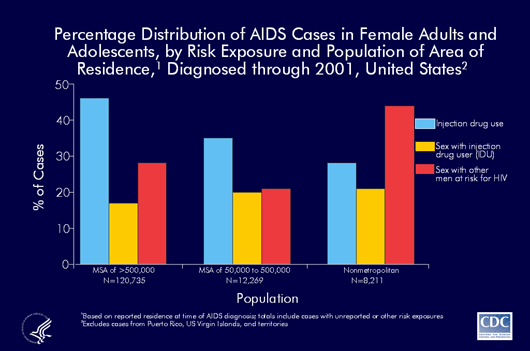|
|
|
|
|
|
||
|
Divisions of HIV/AIDS Prevention |
|||||||
| L206 Series | All Series | Home | Index | Search | Site Map |
HIV/AIDS Surveillance in Urban-Nonurban Areas
L206 slide series through 2001
Slide 9 of 12

|
|
NOTE: To download files "right click" mouse on the link for the file to download, and select "Save Link" or "Save Target".
| L206 Series | All Series | Home | Index | Search | Site Map |
|
Percentage Distribution of AIDS Cases in Female Adults and
Adolescents, by Risk Exposure and Population of Area of Residence,
Diagnosed through 2001, United States The pattern of risk distribution by population of area of residence for women reported with AIDS is similar for large and smaller metropolitan areas. In nonmetropolitan areas, the proportion of cases attributed to heterosexual transmission from a man at risk for HIV (other than an injection drug user) is higher than the proportion attributed to other risk exposures. Most of the persons who attributed their infection to heterosexual contact reported that their partners were HIV infected but did not report the partnerís risk category. |
|
Last Updated: March 7, 2003 Centers for Disease Control & Prevention National Center for HIV, STD, and TB Prevention Divisions of HIV/AIDS Prevention Surveillance Branch Contact Us |
